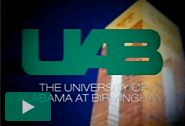Improbable Visions, Inevitable Dreams
 |
When these students gathered outside Tidwell Hall in the early 1970s, the UAB student body numbered close to 7,000. Campus events included UAB Chorus concerts and match play for the newly organized golf team. |
Forty years ago, dreams confronted nightmares in the heart of Birmingham. Remarkably, the dreamers won.
In 1969, the year UAB became an independent campus in the University of Alabama System, the city was still shrouded in the smoke of its fire-breathing steel mills and straining to break the shackles of segregation. But beneath that unpromising exterior, the seeds of change had already taken root.
UAB’s first president, Joseph F. Volker, D.D.S., Ph.D., was convinced that this brand-new university—the product of a marriage between a medical center and a former extension center—could grow up to become a world-class institution. At first, his dreams seemed unreasonable even to his own faculty.
UAB Today |
|
Ranks consistently in the top 25 nationally in funding from the National Institutes of Health and in the top 30 for overall federal funding for research and development. |
| Is among 95 public and private universities (and the only Alabama university) classified as an institution of “very high research activity” by the Carnegie Foundation. |
| Has a student body that is nearly 69 percent full-time; more than 60 percent of freshmen live on campus. |
| Offers students access to more than 3,000 internships, co-ops, and clinical activities each year. |
After their initial meeting with Volker, “everybody felt like he was sort of a wild man, sort of crazy,” recalls retired UAB biochemistry professor Charles Bugg, Ph.D. “He was describing all these big visions of where we would be 20 years from now.... I remember he sounded extremely unlikely and ambitious, and we ended up far exceeding what he projected.”
It didn’t take long for the improbable to become possible, then inevitable. Gleaming new research and education buildings rose on Birmingham’s Southside and were quickly filled by brilliant faculty and students with big ideas of their own.
By 1973, UAB was Birmingham’s second largest employer; five years later, it would be the largest. As the steel industry collapsed, the university helped Birmingham transform itself from an industrial to an intellectual powerhouse. Before Volker’s 20 years were up, UAB had reached the $100 million mark in active grants and contracts. And in 1992, U.S. News & World Report named UAB the number one up-and-coming university in the United States.
Today, UAB is Alabama’s largest single employer, with a $3.6 billion economic impact on the state and research funding topping $400 million. But the university’s contributions reach far beyond the financial. Volker’s “crazy” vision, amplified through thousands of the world’s brightest minds, has sparked advances in education and health care that have improved countless lives.
Explore |
